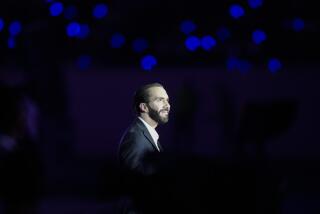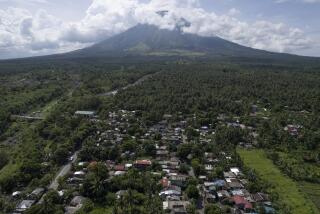Violent Trail of Abu Sayyaf Rebels
- Share via
ZAMBOANGA, Philippines — In its short, violent history, the Abu Sayyaf rebel group has left a trail of death and kidnappings in the southern Philippines but done little to advance its announced goal of creating a “pure” Islamic state.
Its tactics include extortion, assassination and kidnapping for ransom. Hundreds of people have died as a result, villages have been razed, civilians terrorized. Although Abu Sayyaf is believed to have no more than 200 armed followers, it has managed to evade army units in the jungles of Jolo island that have 10 times more men.
The rebel group was little known outside the Philippines until two recent kidnappings. On March 20, Abu Sayyaf took 27 Filipinos, most of them children and teachers, hostage on the nearby island of Basilan. The rebels beheaded two adult captives and executed four others before the army freed most of the hostages in a firefight.
Then, on April 23, Abu Sayyaf snatched 21 hostages--all but one of them non-Filipinos--from the tiny Malaysian resort island of Sipadan. The captives are still being held on Jolo, where government negotiators are trying to win their release. The government says it does not intend to mount a rescue operation that might jeopardize their lives.
On Sunday, President Joseph Estrada came to Zamboanga on Mindanao island, headquarters of the armed forces’ southern command, and was urged by the city’s mayor, Maria Lobregat, to ignore requests for a cease-fire and take a strong military stand against Abu Sayyaf and a larger separatist group, the Moro Islamic Liberation Front, that is also waging a war for independence.
Estrada, addressing troops, delivered a tough message to the separatists, saying the territorial integrity of the Philippines will not be compromised and promising to turn the full force of the military--which has about 30,000 troops on Mindanao--against the “rebels and terrorists” if criminal acts continue. But he indicated that he is willing to negotiate: “If they want peace in Mindanao, we will give them peace.
“We are determined to save the hostages and not put them in harm’s way,” continued Estrada, dressed in combat fatigues and surrounded by his top security aides from Manila. “We just hope the rebels realize keeping the hostages serves no useful purpose whatsoever.”
Abu Sayyaf, or Father of the Sword, was formed in 1991 when Abdujarak Abubakar Janjalani, a young Muslim scholar who had studied Islamic jurisprudence in Saudi Arabia and received military training in Libya, broke off from a large separatist group, the Moro National Liberation Front.
Janjalani, a veteran of guerrilla warfare in Afghanistan, bewildered most Philippine Moros--as Muslims are called here--with his advocacy of a “pure” Islamic society in which movies, dancing and even showing one’s teeth when laughing would be frowned upon. Most of the Philippines’ 5 million practitioners of the Islamic faith, who are heavily concentrated on Mindanao, are Sunni Muslims and have a tradition of moderation and tolerance.
Abu Sayyaf, which was also Janjalani’s nom de guerre, burst into the headlines in 1995 when it attacked and razed the town of Ipil in Zamboanga del Norte province, killing at least 54 civilians. Reportedly financed by Islamic extremists in the Middle East, the group continued its violence with periodic assassinations, kidnappings and seemingly mindless attacks on civilians.
Janjalani was killed in a gun battle with police on Mindanao in 1998 while in his early 30s. Police thought Abu Sayyaf was out of business. But a few months later, the group’s leadership passed to Janjalani’s brother, Khadaffy, about 27 years old, who reportedly knows a great deal about explosives and little about Islamic jurisprudence. Khadaffy Janjalani managed to stitch together a ragtag, dangerous group that the government dismisses as terrorists.
“I have consulted the ulema [Muslim scholars] and read Islamic history, and I believe the violence Abu Sayyaf practices is a deviation from the tenets of Islam,” said Nur Misuari, Estrada’s chief hostage negotiator. Misuari was the leader of the Moro National Liberation Front until 1996, when he ended his call for independence and accepted the government’s offer of Muslim autonomy in four provinces, of which he is now governor.
“There is nothing in the suras [chapters of the Koran] that one can invoke as a precedent for kidnapping and killing. There is nothing that justifies the acts that are taking place,” he said.
Although Muslims on Mindanao have long-standing grievances stemming from years of government neglect--something Estrada has tried to rectify--Abu Sayyaf has mustered little sympathy from the Philippines’ Moro minority and none from the Roman Catholic majority. Few Filipinos understand what the group hopes to accomplish with its kidnappings, except perhaps to attract international attention and additional financial support from Middle Eastern extremists.
Abu Sayyaf had not been heard from for months until its March 20 kidnapping of children and teachers. On April 22, after three warnings to release the hostages, Estrada launched a major attack on the group’s stronghold on Basilan, sending in bombers, helicopters and 1,500 government troops. The next day, the foreign hostages were seized in Malaysia.
More to Read
Sign up for Essential California
The most important California stories and recommendations in your inbox every morning.
You may occasionally receive promotional content from the Los Angeles Times.













